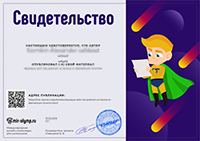| Long-term plan unit: All about me 1 All about me | School: №10 | |||||
| Date: | Teacher name: Iskakova K.S. | |||||
| Grades: 2 | Number present: | absent: - | ||||
| Theme of the lesson: I can... | ||||||
| Learning objectives(s) that this lesson is contributing to | 2.L1 understand a range of short basic supported classroom instructions 2.L2 recognise with considerable support an increasing range of common personal questions 2.S2 ask questions in order to satisfy basic needs and find information on familiar topics and classroom routines 2.S4 respond to basic supported questions giving personal and factual information 2.S8 give simple instructions for others to follow | |||||
| Lesson objectives | All learners will be able to:
Most learners will be able to:
Some learners will be able to:
| |||||
| Success criteria | learners will have succeeded in this class if they: recognize and name 8-9 words correctly make up short dialogue using action verbs and questions Can you..?
| |||||
| Value links | Respect | |||||
| Cross curricular links | Social studies, etiquette | |||||
| ICT skills | Using videos | |||||
| Previous learning | Hello again! | |||||
| Plan | ||||||
| Time | Planned activities | Resources | ||||
| Beginning 10 m (IPW) | Organizational moment
Pronounce phrases hello Very good friends! Now we try to revise numbers with a ball . I begin and you continue from 1 to 10
|
ball
| ||||
| Middle 25 m (IW)
(G)
(I) | . Introduction of the topic “shapes” Now, let’s look at the screen and watch a video. -What can you see? What have you seen? How we can name then in one word “shapes” Teacher models use and meaning of can / can’t to talk about ability through video presentation and demonstration with learners at front of class (W]) Use slides /flashcards and ask Can questions to elicit answers about different abilities Yes she/ they can No they can’t etc. Activity 3 (G) Call different groups of learners to the front of the class and give them different Can you do this? challenges (according to their interests) Activity 4 (P, W) Give learners worksheets with images of different abilities [common verbs - ride a bike Activity 6 Learners take turns to ask their partners if they can say what the image requires them to. Can you write? Can you read? Can you sing? Can you fly? Can you swim? Can you jump? Can you say 1-10 in English? Can you say three colours? Plenary (W)(f) Play a game. Name an action using can patterns, such as "Can you...?" "Yes, I can" "No, I can't". The actions are fun: jump, dance, run quickly, touch your toes, cross your eyes, snap your fingers, whistle, sing, etc. E.g. "Can you cross your eyes?". If the student replies "Yes, I can" then say "Ok, go!" and the student does the action. If the student says "No, I can't" say "Not good. Ok, can you (jump)?" |
https://youtu.be/boEJBYwHod4?t=3
A3 paper, glue
| ||||
| End 5 mins | Feedback Pupils share opinions if they liked/disliked the lesson by putting their thumbs up/down and explaining the reasons using simple language |
| ||||
| Additional information | ||||||
| Differentiation – how do you plan to give more support? How do you plan to challenge the more able learners? | Assessment – how are you planning to check learners’ learning? | Health and safety check | ||||
| More support will be given to weaker learners by giving them a modified worksheets in some tasks with greater support | By means of oral formative assessment – students work in groups making dialogs – teacher monitors for assessment |
| ||||
| Reflection Were the lesson objectives/learning objectives realistic? Did all learners achieve the LO? If not, why? Did my planned differentiation work well? Did I stick to timings? What changes did I make from my plan and why? |
| |||||
| Summary evaluation What two things went really well (consider both teaching and learning)? 1:
2:
What two things would have improved the lesson (consider both teaching and learning)? 1:
2:
What have I learned from this lesson about the class or achievements/difficulties of individuals that will inform my next lesson?
| ||||||


 2099
2099 73
73 Краткосрочное планирование "I can."
Краткосрочное планирование "I can." 